1994 CHEVROLET CORVETTE service
[x] Cancel search: servicePage 238 of 274
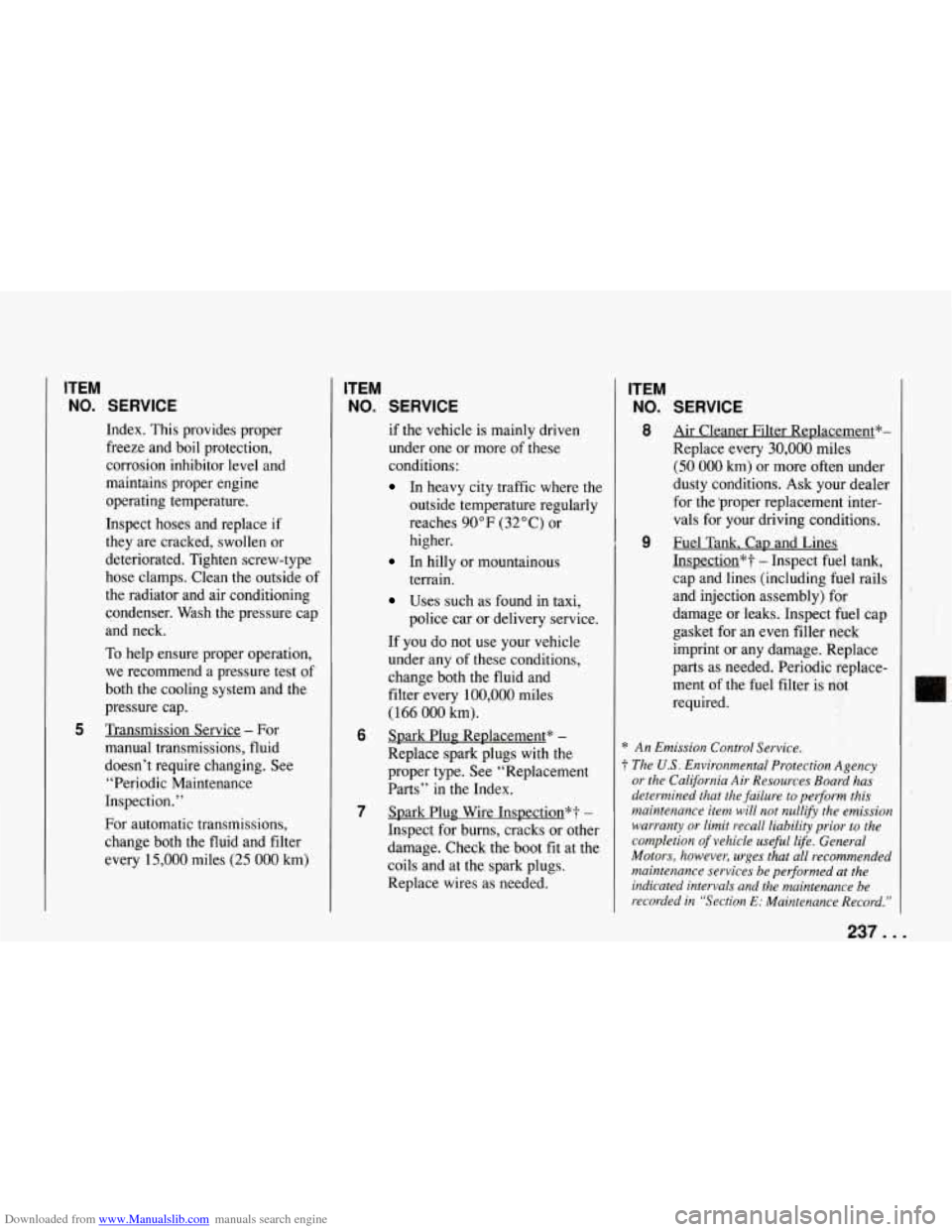
Downloaded from www.Manualslib.com manuals search engine ITEM
NO. SERVICE
Index. This provides proper
freeze and boil protection,
corrosion inhibitor level and
maintains proper engine
operating temperature.
Inspect hoses and replace if
they are cracked, swollen or
deteriorated. Tighten screw-type
hose clamps. Clean the outside of
the radiator and air conditioning
condenser. Wash the pressure cap
and neck.
To help ensure proper operation,
we recommend a pressure test of
both the cooling system and the
pressure cap.
5 Transmission Service - For
manual transmissions, fluid
doesn’t require changing. See
“Periodic Maintenance
Inspection.”
For automatic transmissions,
change both the fluid and filter
every
15,000 miles (25 000 km)
ITEM
NO. SERVICE
if the vehicle is mainly driven
under one or more of these
conditions:
In heavy city traffic where the
outside temperature regularly
reaches
90 OF (32 O C) or
higher.
In hilly or mountainous
terrain.
Uses such as found in taxi,
police car or delivery service.
If you do not use your vehicle
under any of these conditions,
change both
the fluid and
filter every
100,000 miles
(1 66 000 km).
Replace spark plugs with the
proper type. See “Replacement
Parts” in the Index.
6 Spark Plug Replacement* -
7 Spark Plug Wire Inspection*? -
Inspect for burns, cracks or other
damage. Check the boot fit at the
coils and at the spark plugs.
Replace wires as needed.
ITEM
NO. SERVICE
8 Air Cleaner Filter Replacement*-
Replace every
30,000 miles
(50 000 km) or more often under
dusty conditions. Ask your dealer
for the ’proper replacement inter-
vals for your driving conditions.
Inspection*?
- Inspect fuel tank,
cap and lines (including fuel rails
and injection assembly) for
damage or leaks. Inspect fuel cap
gasket for an even filler neck
imprint or any damage. Replace
parts as needed. Periodic replace-
ment of the fuel filter is not
required.
9 Fuel Tank. Cap and Lines
* An Emission Control Service.
t The U.S. Environmental Protection Agency
or the California Air Resources Board has
determined that the failure to perform this
maintenance item will not nullify the emission
warranty or limit recall liability prior to the
completion
of vehicle useful life. General
Motors, however, urges that all recommended
maintenance services be performed at the
indicated intervals and the maintenance be
recorded in “Section
E: Maintenance Record.”
I -I
237. . .
Page 239 of 274
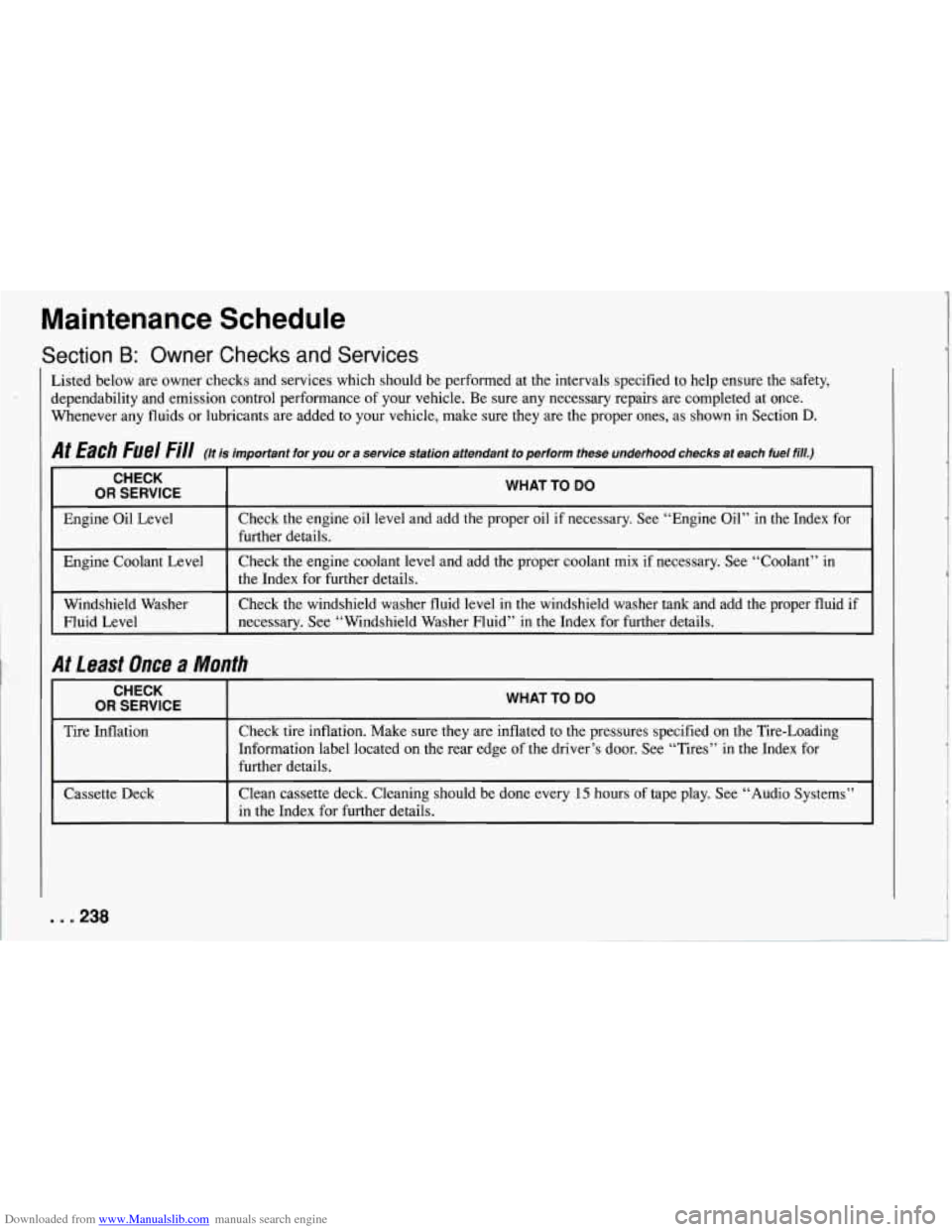
Downloaded from www.Manualslib.com manuals search engine Maintenance Schedule
Section B: Owner Checks and Services
isted below are owner checks and services which should be performed at the intervals specified to help ensure the safety,
ependability and emission control performance of your vehicle. Be sure any necessary repairs are completed at once.
Vhenever any fluids or lubricants are added
to your vehicle, make sure they are the proper ones, as shown in Section D.
If Each Fuel Fill (/t is important for you or a service station attendant to perform these underhood checks at each fuel fill.)
i CHECK
OR SERVICE I WHAT TO DO
Engine Oil Level
Check the windshield washer fluid level in the windshield washer
tank and add the proper fluid if
Windshield Washer Check
the engine coolant level and add the proper coolant mix if necessary. See “Coolant” in
Engine Coolant Level Check the
engine oil level and add the proper oil if necessary. See “Engine Oil” in the Index for
Fluid Level necessary.
See “Windshield Washer Fluid” in the Index for further details.
further details.
the
Index for further details.
It Least Once a Month
CHECK
OR SERVICE
Tire Inflation
Cassette Deck
WHAT TO DO
Check tire inflation. Make sure they are inflated to the pressures specified on the Tire-Loading
Information label located on the rear edge
of the driver’s door. See “Tires” in the Index for
further details.
Clean cassette deck. Cleaning should be done every
15 hours of tape play. See “Audio Systems”
in the Index for further details.
. .238
Page 240 of 274
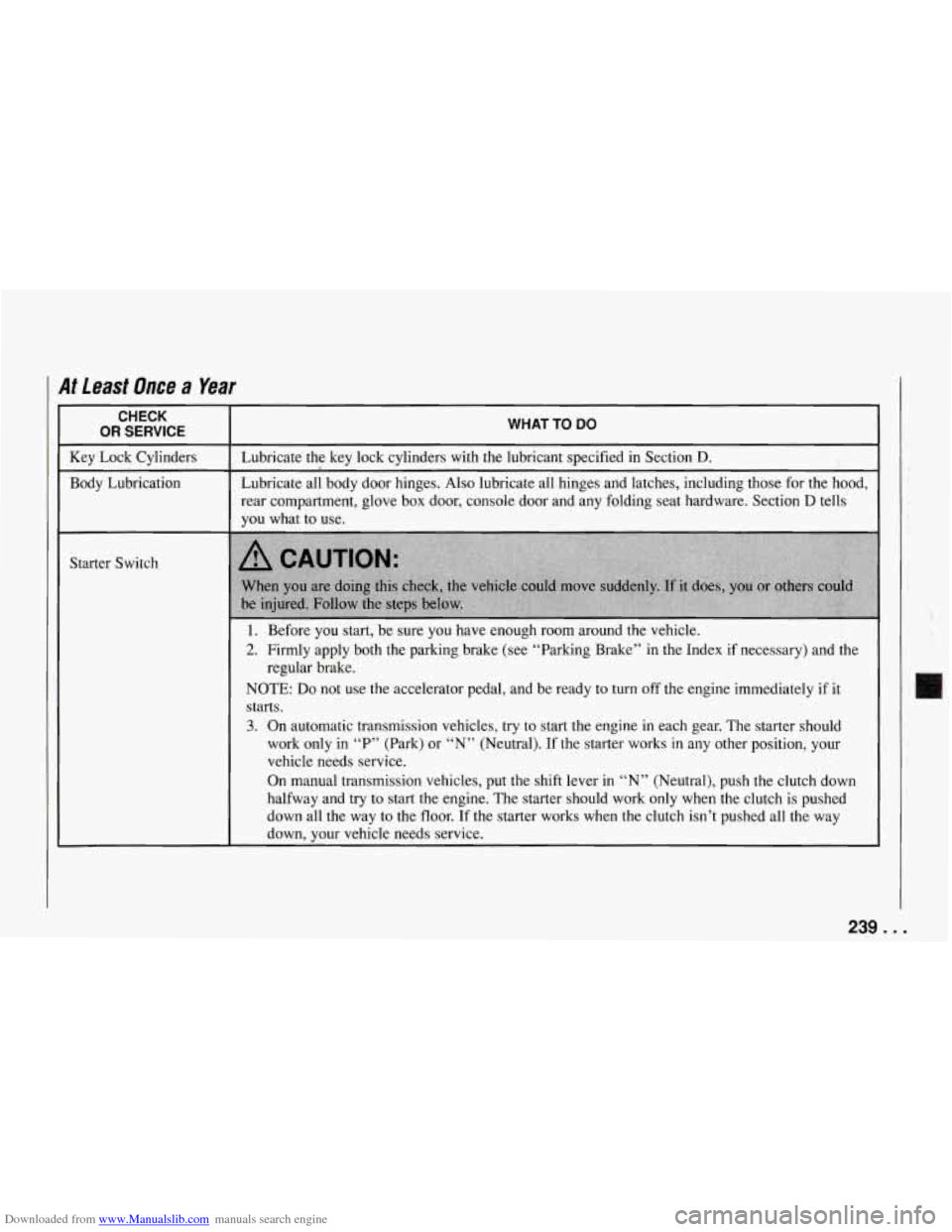
Downloaded from www.Manualslib.com manuals search engine I At Least Once a Year
WHAT TO DO
Lubricate the key lock cylinders with the lubricant specified in Section D.
Lubricate all body door hinges. Also lubricate all hinges and latches, including those for the hood,
rear compartment, glove box door, console door and any folding seat hardware. Section
D tells
you what to use.
1. Before you start, be sure you have enough room around the vehicle.
2. Firmly apply both the parking brake (see “Parking Brake” in the Index if necessary) and the
regular brake.
....
NOTE: Do not use the accelerator pedal, and be ready to turn off the engine immediately if it
starts.
3. On automatic transmission vehicles, try to start the engine in each gear. The starter should
work only in
“P” (Park) or “N” (Neutral). If the starter works in any other position, your
vehicle heeds service.
On manual transmission vehicles, put the shift lever in “N” (Neutral), push the clutch down
halfway and try to start the engine. The starter should work only when the clutch is pushed
down all the way to the floor. If the starter works when the clutch isn’t pushed all the way
down, your vehicle needs service.
r::. ,; II
U
239. . .
Page 241 of 274

Downloaded from www.Manualslib.com manuals search engine At Least Once a Year (CONT.)
CHECK
OR SERVICE
Brake-Transmission Shift Interlock
- BTSI
(Automatic Transmis-
sion)
Maintenance Schedule
Section B: Owner Checks and Services (Cont.)
Steering Column Lock
WHAT TO DO
1. Before you start, be sure you have enough room around the vehicle. It should be parked on a
2. Firmly apply the parking brake (see “Parking Brake” in the Index if necessary).
NOTE: Be ready to apply the regular brake immediately if the vehicle begins to move.
3. With the engine off, turn the key to the “RUN” position, but don’t start the engine. Without
applying the regular brake, try to move the shift lever out of “P” (Park) with normal effort.
If the shift lever moves out of “P” (Park), your vehicle’s BTSI needs service.
level surface.
While parked, and with the parking brake set,
try to turn the key to “LOCK” in each shift lever
position.
0 With an automatic transmission, the key should turn to “LOCK” only when the shift lever is
With a manual transmission, the key should turn to “LOCK” only when the shift lever is in
On vehicles with a key release button, try to turn the key to “LOCK” without pressing the
button. The key should turn to. “LOCK” only with the key button depressed. On all vehicles,
the key should come out only in “LOCK.”
in
“P” (Park).
“R” (Reverse).
. . .240
Page 242 of 274
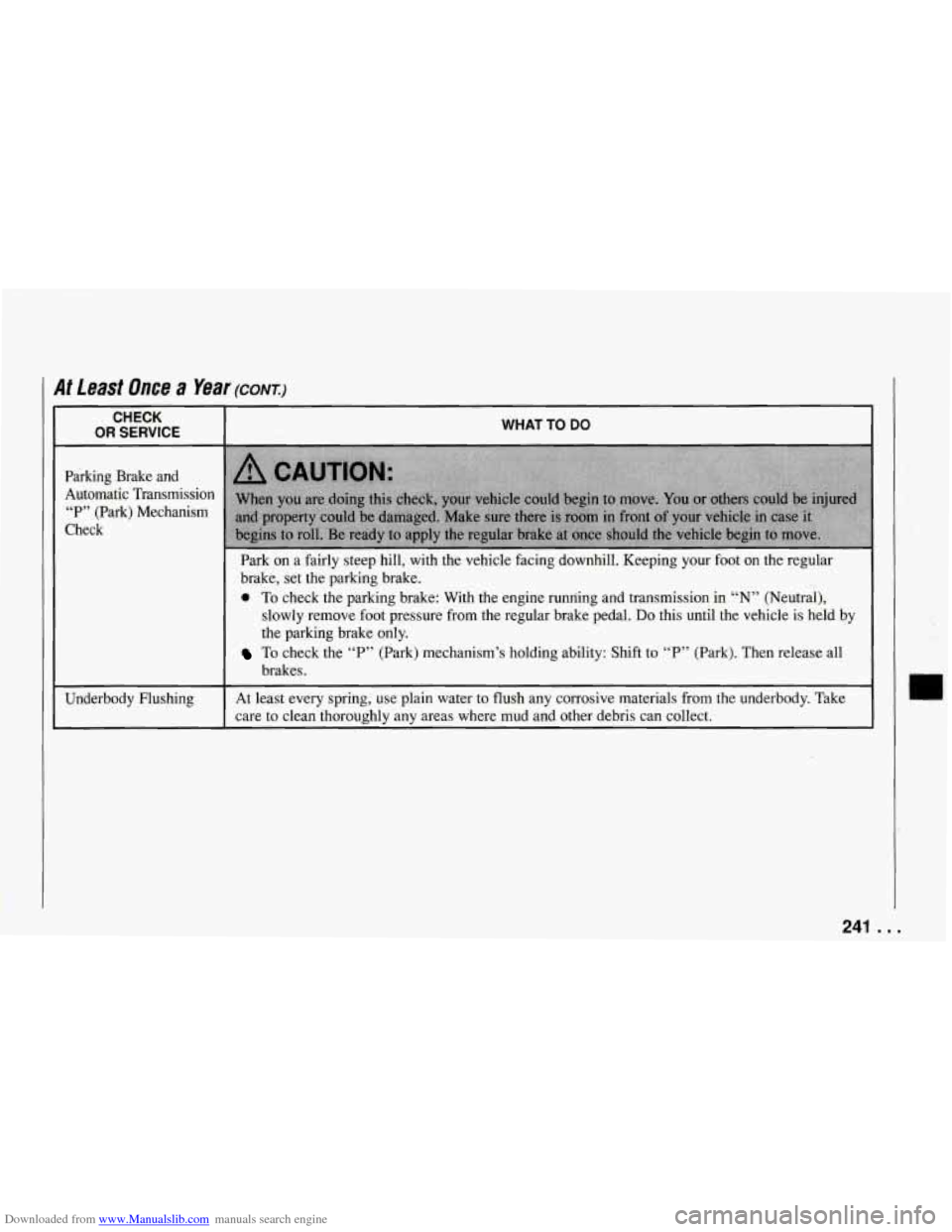
Downloaded from www.Manualslib.com manuals search engine I At Least Once a Year (CONI)
CHECK
OR SERVICE ~~ ~
Parking Brake and
Automatic Transmission “P” (Park) Mechanism
Check
Underbody Flushing
WHAT TO DO
Park on a fairly steep hill, with the vehicle facing downhill. Keeping \
your foot on the regular
brake, set the parking brake.
0 To check the parking brake: With the engine runriing and transmission in “N” (Neutral),
slowly remove foot pressure from the regular brake pedal.
Do this until the vehicle is held by
the parking brake only.
brakes.
To check the “P” (Park) mechanism’s holding ability: Shift to “P” (Park). Then release all
At least every spring, use plain water to flush any corrosive mat\
erials from the underbody. Take
care to clean thoroughly any areas where mud and other debris can collect. I I
241 . . .
Page 243 of 274

Downloaded from www.Manualslib.com manuals search engine Maintenance Schedule
I Section C: Periodic Maintenance Inspections
I
S
isted below are inspections and services which should be performed at least twice a year (for instance, each spring and fall). You
hould let your GM dealer’s service department or other qualified service center do these jobs. Make sure any necessary repairs are
ompleted at once.
INSPECTION
OR SERVICE
Restraint Systems
Steering and
‘Suspension Inspection
Tire and Wheel Inspection
Exhaust System
Inaection
. .242
WHAT SHOULD BE DONE
Now and then, make sure all your belts, buckles, latch plates, retractots, anchorages and
reminder systems are working properly.
Look for any loose parts or damage. If you see anything
that might keep a restraint system from doing its job, have
it repaired.
Inspect the front and rear suspension and steering systenl for damaged, loose or missing parts,
signs of wear, or lack
of lubrication. Inspect the power steering lines and hoses for proper
hookup, binding, leaks, cracks, chafing, etc.
Inspect the tires for uneven wear or damage. If there is irregular or premature wear, check
the
wheel alignment. Inspect for damaged wheels.
Inspect the complete exhaust system. Inspect the body near the \
exhaust system.
Look for broken,
damaged, missing or out-of-position parts as well as open seams, holes, loose connections, or
other conditions which could cause a heat build-up in
the floor pan or could let exhaust fumes
into the vehicle. See “Engine Exhaust”
in the Index.
Page 244 of 274
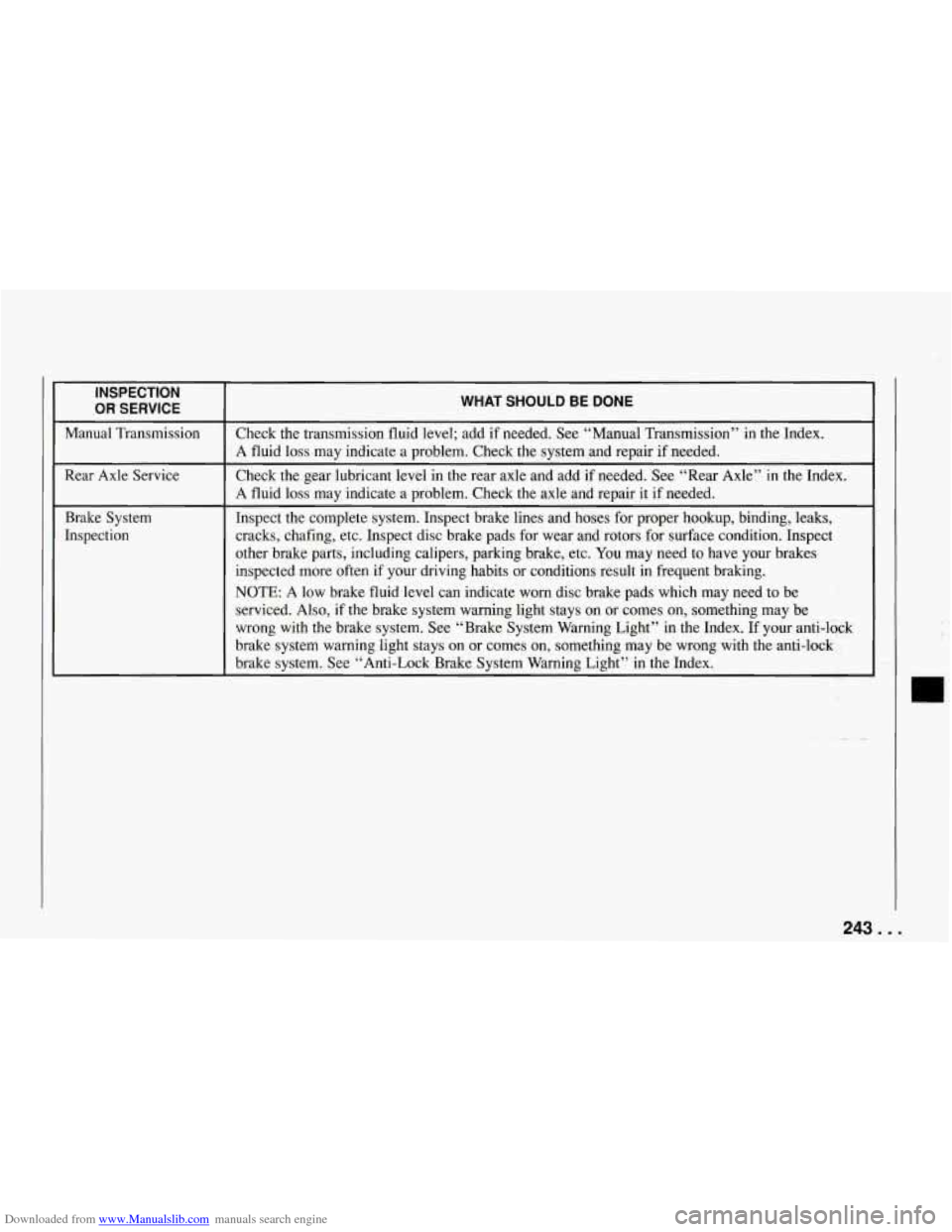
Downloaded from www.Manualslib.com manuals search engine INSPECTION
OR SERVICE
I WHAT SHOULD BE DONE
Manual Transmission
Inspect the complete system. Inspect brake lines and hoses for proper hookup, binding, leaks,
Brake System Check the gear lubricant level in the rear axle and add
if needed. See “Rear Axle” in the Index.
Rear Axle Service Check the transmission fluid level;
add if needed. See “Manual Transmission” in the Index.
Inspection cracks, chafing, etc. Inspect disc brake pads
for wear and rotors for surface condition. Inspect
A fluid loss may indicate a problem. Check the system and rep\
air
if needed.
A fluid loss may indicate a problem. Check the axle and repair it
if needed.
other brake parts, including calipers, parking brake, etc. You may need to have your brakes
inspected more often if your driving habits or conditions result in frequent braking.
NOTE: A low brake fluid level can indicate worn disc brake pads whi\
ch may need to be
serviced. Also, if the brake system warning light stays on or comes on, something may be
wrong with the brake system. See “Brake System Warning Light” in the Index.
If your anti-lock
brake system warning light stays on or comes on, something may be wrong with the anti-lock
brake system. See
“ Anti-Lock Brake System Warning Light” in the Index.
I 1
243. . .
Page 245 of 274
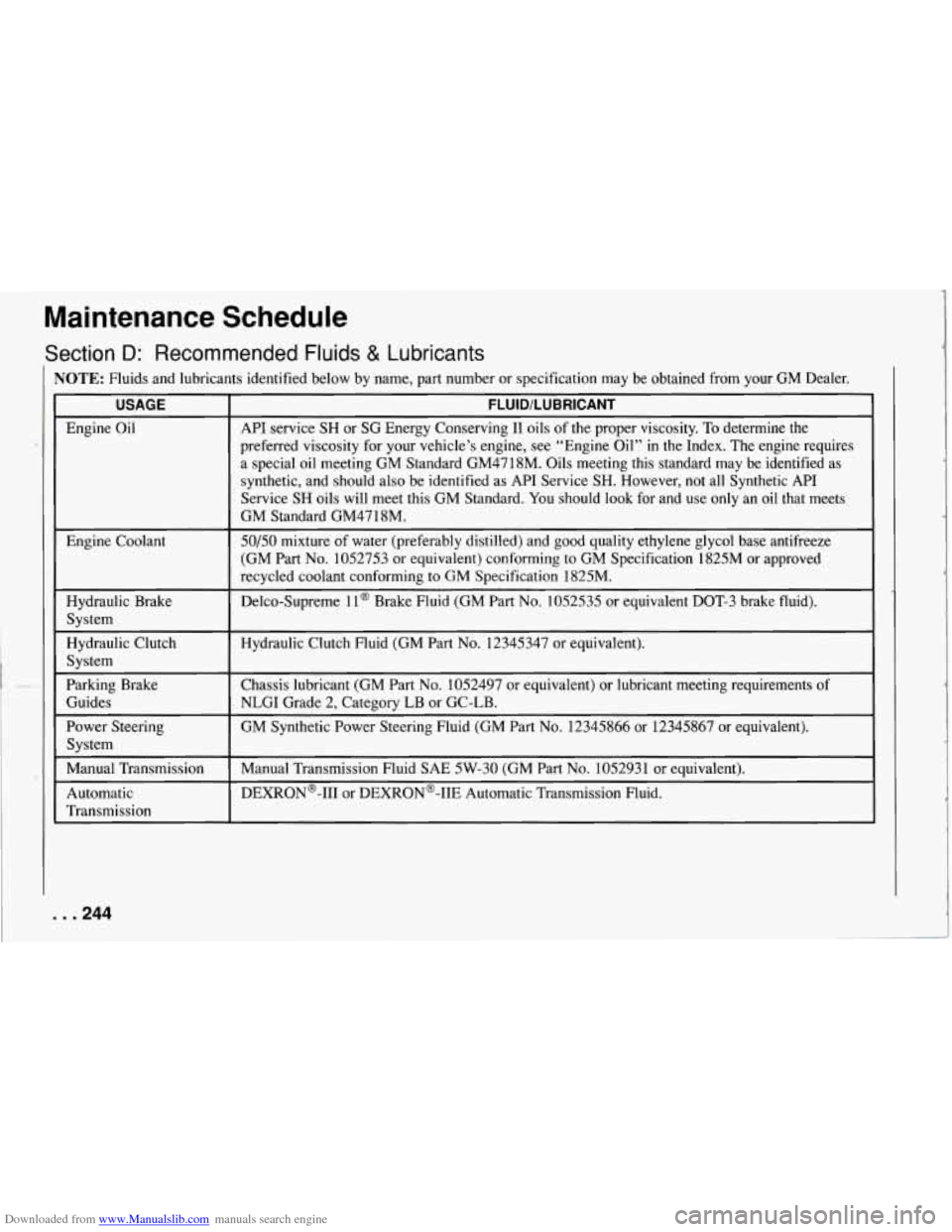
Downloaded from www.Manualslib.com manuals search engine Maintenance Schedule
Section D: Recommended Fluids & Lubricants
NOTE: Fluids and lubricants identified below by name, part number or specification may be obtained from your GM Dealer.
USAGE FLUID/LUBRICANT
Engine Oil
API service SH or SG Energy Conserving I1 oils of the proper viscosity. To determine the
preferred viscosity for your vehicle’s engine, see “Engine Oil” in the Index. The engine requires
a special oil meeting GM Standard GM4718M. Oils meeting this stan\
dard may be identified as
synthetic, and should also be identified as API Service SH. However, not all Synthetic API
Service SH oils will meet this GM Standard.
You should look for and use only an oil that meets
GM Standard GM4718M.
Engine Coolant
50/50 mixture of water (preferably distilled) and good quality ethylene glycol base antifreeze
(GM Part No. 1052753 or equivalent) conforming to GM Specification 1825M or approved
recycled coolant conforming to GM Specification 1825M.
Hydraulic Brake Delco-Supreme
ll@ Brake Fluid (GM Part No. 1052535 or equivalent DOT-3 brake fluid).
System
Hydraulic Clutch System Hydraulic Clutch Fluid
(GM Part No. 12345347 or equivalent).
Parking Brake
Chassis lubricant (GM Part No. 1052497 or equivalent) or lubricant meeting requirements of
Guides NLGI Grade 2, Category LB or GC-LB.
Power Steering
GM Synthetic Power Steering Fluid (GM Part
No. 12345866 or 12345867 or equivalent).
System
Manual Transmission
Transmission DEXRON@-I11 or
DEXRON@-IIE Automatic Transmission Fluid.
Automatic Manual Transmission Fluid
SAE 5W-30 (GM Part
No. 1052931 or equivalent).
. . .244